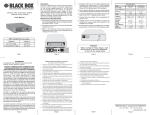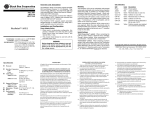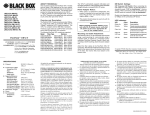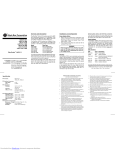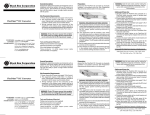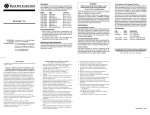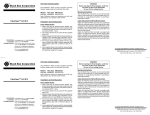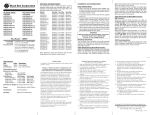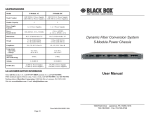Download (a) (b) (c) (d) 1000 Park Drive · Lawrence, PA 15055-1018 724
Transcript
Dynamic Fiber Conversion System 100Tx-Fx User Manual DFCS 100Tx-Fx - Dual Fiber Modules Connector Type Distances ST SC MM 5 km LMC3023C LMC3026C SM 30 km LMC3024C LMC3027C SM 60 km LMC3025C LMC3028C DFCS 100Tx-Fx - Single-Fiber Modules Connector Type SM, SF Distances Tx: 1310nm; Rx: 1550nm Tx: 1550nm; Rx: 1310nm 20 km LMC3029C LMC3031C CUSTOMER Order toll-free in the U.S.: Call 877-877-BBOX SUPPORT (outside U.S. call 724-746-5500) INFORMATION FREE technical support 24 hours a day, 7 days a week; Call 724-746-5500 or fax 724-746-0746 Mailing address: Black Box Corporation, 1000 Park Drive, Lawrence, PA 15055-1018 Web site: www.blackbox.com E-mail: [email protected] Description: The DFCS 100Tx-Fx converters support the IEEE 802.3 Ethernet standard and convert 100 Mbps 100Base-Fx fiber to 100Base-Tx unshielded twisted pair (UTP). Models are available for multimode (MM) and singlemode (SM) dual fiber and single-mode single-fiber. The 100Tx-Fx supports UTP Half-Duplex and FullDuplex auto-negotiation with manual override and features a cross-over UTP switch for easy attachment to hubs, switches and workstations. The 100Tx-Fx can be used in an unmanaged or managed fashion. When unmanaged, it can be installed in a chassis without a SNMP and Telnet Management Module (MGT). To be managed, a MGT module must be installed in the same chassis. LS (a) In “Link Propagate” (LP), sometimes referred to as “Link Loss Carry Forward”, a converter port transmits a “Link” signal only when receiving a “Link” at its other port. For example, the UTP transmits a “Link” only when receiving a “Link” at the fiber port. [Fig 1(c)]. In “Remote Fault Detection” (RFD), the UTP port transmits a “Link” signal only when receiving a “Link” at Page 2 Mounting and Cable Attachment: Model SPECIFICATIONS 100Tx-Fx Protocols 100Base-Tx, 100Base-Fx Copper Connectors RJ-45 Fiber Connectors Controls LED Displays Dimensions ST or SC LS/LP, RFD, UTP crossover, Auto/Man, FDX/HDX Pwr, Fiber link, UTP link, Auto, FDX/HDX W:0.85" x D:4.5" x H:2.8" Weight 8 oz. Compliance UL, CE, FCC Class A, NEBS 3 Temperature -Operating -Storage 0 to 50 C -40 to 80 C Altitude 0-10,000 ft MTBF (hrs) 1,200,000 Converter A Converter B LS LS Switch 2 (b) Switch 1 Converter A Converter B LP Switch 2 LP (c) Switch 1 Converter A Converter B LP RFD Switch 2 “Link Seg/Link Prop” Dip-Switch: When in the “Link Seg” (factory setting) position (and when the “R/Flt Det” dip-switch is in the “Norm” position), the LS mode is selected. When in the “Link Prop” position, LP mode is enabled. TRADEMARKS All applied-for and registered trademarks are the property of their respective owners. FEDERAL COMMUNICATIONS COMMISSION AND CANADIAN DEPARTMENT OF COMMUNICATIONS RADIO FREQUENCY INTERFERENCE STATEMENTS This equipment generates, uses, and can radiate radio frequency energy and if not installed and used properly, that is, in strict accordance with the manufacturer’s instructions, may cause interference to radio communication. It has been tested and found to comply with the limits for a Class A computing device in accordance with the specifications in subpart B of Part 15 of FCC rules, which are designed to provide reasonable protection against such interference when the equipment is operated in a commercial environment. Operation of this equipment in a residential area is likely to be cause interference, in which case the user at his own expense will be required to take whatever measures may be necessary to correct the interference. When in the “FDX” position (factory setting), the converter operates in full-duplex. When in the “HDX” position it operates in half-duplex. Note that setting the “Link Seg/Link Prop” to “Link Prop” (LP mode) and the “ R/Flt Det” to “R/Flt Det” (RFD mode) on the same module is an illegal mode that will result in unpredictable behavior. “RJ45 Cross-Over” Switch: When connecting the UTP to a hub or switch, set switch to “Straight-Through” (factory setting). When connecting to a workstation, set it to “Cross-Over.” Note that connecting two converters when both are set to RFD mode is illegal and will cause a “deadly embrace” lockup. LED Indicators: LED Color Description Pwr: Yellow On--Power on F/O Lk: Green On--Link; Blink--Activity AN: Green On--UTP Auto-Negotiation enabled FDx: Green On--Full-Duplex mode UTP/Link: Green On--UTP Link; Blink--Activity 1. 2. 3. 4. 5. 6. 7. 8. 9. Changes or modifications not expressly approved by the party responsible for compliance could void the user’s authority to operate the equipment. Page 8 “FDX/HDX” UTP Full/Half Duplex Dip-Switch: When the “AN/Man” dip-switch is in the “Man” position, the “FDX/HDX” dip-switch selects the duplex mode for the converter. “R/Flt Det” Remote Fault Detection Dip-Switch: When in the “R/Flt Det” position, the RFD mode is selected. When in the “Norm” (factory setting) position, RFD is disabled. Page 4 Switch 2 When in the “Man” (Manual) position, the converter does not auto-negotiate and operates in the mode selected by the “FDX/HDX” dip-switch. Note that attaching an auto-negotiating UTP port to a non-auto-negotiating (manual / forced / hardcoded) UTP port may result in an unpredictable port setting with excessive collisions and poor link performance. When operating in manual mode both mating ports MUST be set manually to the same speed and duplex mode. Page 3 Converter B Le présent appareil numérique n’émet pas de bruits radioélectriques dépassant les limites applicables aux appareils numéirques de las classe A prescrites dans le Règlement sur le brouillage radioélectrique publié par le ministère des Communications du Canada. Page 7 Link Prop =Link Propagate R/Flt Det =Remote Fault Detect =UTP Manual Man =UTP Half Duplex HDX Fig 1: Link Modes Converter A This digital apparatus does not exceed the Class A limits for radio noise emission from digital apparatus set out in the Radio Interference Regulation of the Canadian Department of Communications. Page 6 Link Segment= Link Seg Normal= Norm UTP Auto Negotiate= AN UTP Full Duplex= FDX “AN/Man” UTP Auto/Manual Dip-Switch: When in the “AN” (Auto-Negotiation) position (factory setting), the converter auto-negotiates and matches the duplex mode of a mating auto-negotiating device connected to its UTP port. (d) Switch 1 Front Panel Dip-Switch Settings: Fig 2: Dip-Switches UTP Fiber In order to accommodate different user needs, the 100Tx-Fx supports three different linking modes. In “Link Segment” (LS), sometimes referred to as the “Normal” mode, a converter port transmits a “Link” signal independently of any received “Link” at any other port. For example, the UTP transmits a “Link” regardless of the fiber receiving a “Link” [Fig 1(b)]. LS Fiber UTP Switch 1 Link Modes: Page 1 The DFCS modules are hot-swappable and can be installed into any DFCS chassis. 1. Using the chassis’ module guides for alignment, insert the module into the selected slot and secure using the front panel fastener screw. 2. Using a Category 5 cable attach the UTP port to a mating 100Base-Tx Ethernet device port. 3. Using a multimode or single-mode dual-fiber cable as required per the converter type, attach the fiber port to a 100Base-Fx mating Ethernet device. The transmit (Tx) must attach to the receive side of the mating device and the receive (Rx) must attach to the transmit side. 4. Single fiber (SF) converters must be used in matched pairs. The transmit (Tx) and receive (Rx) wavelengths of one converter must match the receive (Rx) and transmit (Tx) wavelengths of the mating converter (e.g. LMC3029C must be used with the LMC3031C). Only a single-fiber cable is required to connect the mating devices. the fiber port. The fiber port transmits a “Link” only when receiving “Link” signals both at the fiber port and the UTP port. As a result, fiber faults (no “Link” received at the fiber) are looped-back and can be reported to the network’s core [Fig 1(d)]. 10. 11. 12. 13. NORMAS OFICIALES MEXICANAS (NOM) ELECTRICAL SAFETY STATEMENT Todas las instrucciones de seguridad y operación deberán ser leídas antes de que el aparato eléctrico sea operado. Las instrucciones de seguridad y operación deberán ser guardadas para referencia futura. Todas las advertencias en el aparato eléctrico y en sus instrucciones de operación deben ser respetadas. Todas las instrucciones de operación y uso deben ser seguidas. El aparato eléctrico no deberá ser usado cerca del agua—por ejemplo, cerca de la tina de baño, lavabo, sótano mojado o cerca de una alberca, etc. El aparato eléctrico debe ser usado únicamente con carritos o pedelstales que sean recomendados por el fabricante. El aparato eléctrico debe ser montado a la pared o al techo sólo como sea recomendado por el fabricante. Servicio—El usuario no debe intentar dar servicio al equipo eléctrico más allá a lo descrito en las instrucciones de operación. Todo otro servicio deberá ser referido a personal de servicio calificado. El aparato eléctrico debe ser situado de tal manera que su posición no interfiera su uso. La colocación del aparato eléctrico sobre una cama, sofá, alfombra or superficie similar puede bloquea la ventilación, no se debe colocar en libreros o gabinetes que impidan el flujo de aire por los orificios de ventilación. El equipo eléctrico deber ser situado fuera del alcance de fuentes de calor como radiadores, registros de calor, estufas u ostros aparatos (incluyendo amplificadores) que producen calor. El aparato eléctrico deberá ser connectado a una fuente de poder sólo del tipo descrito en el instructivo de operación, o como se indique en el aparato. Precación debe ser tomada de tal manera que la tierra fisica y la polarización del equipo no sea eliminada. Los cables de la fuente de poder deben ser guiados de tal manera que no sean pisados ni pellizcados por objetos colocados sobre o contra ellos, poniendo particular atención a los contactos y Page 9 Page 5 receptáculos donde salen del aparato. 14. El equipo eléctrico debe ser limpiado únicamente de acuerdo a las recomendaciones del fabricante. 15. En caso de existir, una antena externa deberá ser localizada lejos de las lineas de energia. 16. El cable de corriente deberá ser desconectado del cuando el equipo no sea usado por un largo periodo de tiempo. 17. Cuidado debe ser tomado de tal manera que objectos liquidos no sean derramados sobre la cubierta u orificios de ventilación. 18. Servicio por personal calificado deberá ser provisto cuando: A: El cable de poder o el contacto ha sido dañado; u B: Objectos han caído o líquido ha sido derramado dentro del aparato; o C: El aparato ha sido expuesto a la lluvia; o D: El aparato parece no operar normalmente o muestra un cambio en su desempeño; o E: El aparto ha sido tirado o su cubierta ha sido dañada. ©Copyright 2003. Black Box Corporation. All rights reserved. 1000 Park Drive · Lawrence, PA 15055-1018 724-746-5500 · Fax 724-746-0746 040-L3023-001A 11/03 Page 10 Mounting and Cable Attachment: The DFCS modules are hot-swappable and can be installed into any DFCS chassis. 1. Using the chassis’ module guides for alignment, insert the module into the selected slot and secure using the front panel fastener screw. 2. Using a Category 5 cable attach the UTP port to a mating 100Base-Tx Ethernet device port. 3. Using a multimode or single-mode dual-fiber cable as required per the converter type, attach the fiber port to a 100Base-Fx mating Ethernet device. The transmit (Tx) must attach to the receive side of the mating device and the receive (Rx) must attach to the transmit side. 4. Single fiber (SF) converters must be used in matched pairs. The transmit (Tx) and receive (Rx) wavelengths of one converter must match the receive (Rx) and transmit (Tx) wavelengths of the mating converter (e.g. LMC3029C must be used with the LMC3031C). Only a single-fiber cable is required to connect the mating devices. Model SPECIFICATIONS 100Tx-Fx Protocols 100Base-Tx, 100Base-Fx Copper Connectors RJ-45 Fiber Connectors Controls LED Displays Dimensions ST or SC LS/LP, RFD, UTP crossover, Auto/Man, FDX/HDX Pwr, Fiber link, UTP link, Auto, FDX/HDX W:0.85" x D:4.5" x H:2.8" Weight 8 oz. Compliance UL, CE, FCC Class A, NEBS 3 Temperature -Operating -Storage 0 to 50 C -40 to 80 C Altitude 0-10,000 ft MTBF (hrs) 1,200,000 TRADEMARKS All applied-for and registered trademarks are the property of their respective owners. FEDERAL COMMUNICATIONS COMMISSION AND CANADIAN DEPARTMENT OF COMMUNICATIONS RADIO FREQUENCY INTERFERENCE STATEMENTS This equipment generates, uses, and can radiate radio frequency energy and if not installed and used properly, that is, in strict accordance with the manufacturer’s instructions, may cause interference to radio communication. It has been tested and found to comply with the limits for a Class A computing device in accordance with the specifications in subpart B of Part 15 of FCC rules, which are designed to provide reasonable protection against such interference when the equipment is operated in a commercial environment. Operation of this equipment in a residential area is likely to be cause interference, in which case the user at his own expense will be required to take whatever measures may be necessary to correct the interference. Le présent appareil numérique n’émet pas de bruits radioélectriques dépassant les limites applicables aux appareils numéirques de las classe A prescrites dans le Règlement sur le brouillage radioélectrique publié par le ministère des Communications du Canada. Dynamic Fiber Conversion System 100Tx-Fx User Manual DFCS 100Tx-Fx - Dual Fiber Modules Connector Type Distances ST SC MM 5 km LMC3023C LMC3026C SM 30 km LMC3024C LMC3027C SM 60 km LMC3025C LMC3028C DFCS 100Tx-Fx - Single-Fiber Modules Connector Type Distances Tx: 1310nm; Rx: 1550nm Tx: 1550nm; Rx: 1310nm SM, SF 20 km LMC3029C LMC3031C CUSTOMER Order toll-free in the U.S.: Call 877-877-BBOX SUPPORT (outside U.S. call 724-746-5500) INFORMATION FREE technical support 24 hours a day, 7 days a week; Call 724-746-5500 or fax 724-746-0746 Mailing address: Black Box Corporation, 1000 Park Drive, Lawrence, PA 15055-1018 Web site: www.blackbox.com E-mail: [email protected] Page 1 Page 7 Page 8 Description: The DFCS 100Tx-Fx converters support the IEEE 802.3 Ethernet standard and convert 100 Mbps 100Base-Fx fiber to 100Base-Tx unshielded twisted pair (UTP). Models are available for multimode (MM) and singlemode (SM) dual fiber and single-mode single-fiber. the fiber port. The fiber port transmits a “Link” only when receiving “Link” signals both at the fiber port and the UTP port. As a result, fiber faults (no “Link” received at the fiber) are looped-back and can be reported to the network’s core [Fig 1(d)]. The 100Tx-Fx supports UTP Half-Duplex and FullDuplex auto-negotiation with manual override and features a cross-over UTP switch for easy attachment to hubs, switches and workstations. The 100Tx-Fx can be used in an unmanaged or managed fashion. When unmanaged, it can be installed in a chassis without a SNMP and Telnet Management Module (MGT). To be managed, a MGT module must be installed in the same chassis. LS (a) Page 2 4. 5. 6. 7. 8. 9. Converter A Converter B LS LS Converter A Converter B LP Switch 2 Switch 2 LP (c) Switch 1 Converter A Converter B LP RFD Switch 2 11. 12. 13. Front Panel Dip-Switch Settings: Link Segment= Link Seg Normal= Norm UTP Auto Negotiate= AN UTP Full Duplex= FDX Link Prop =Link Propagate R/Flt Det =Remote Fault Detect =UTP Manual Man =UTP Half Duplex HDX “Link Seg/Link Prop” Dip-Switch: When in the “Link Seg” (factory setting) position (and when the “R/Flt Det” dip-switch is in the “Norm” position), the LS mode is selected. When in the “Link Prop” position, LP mode is enabled. 040-L3023-001A 11/03 Page 10 When in the “Man” (Manual) position, the converter does not auto-negotiate and operates in the mode selected by the “FDX/HDX” dip-switch. “FDX/HDX” UTP Full/Half Duplex Dip-Switch: When the “AN/Man” dip-switch is in the “Man” position, the “FDX/HDX” dip-switch selects the duplex mode for the converter. When in the “FDX” position (factory setting), the converter operates in full-duplex. When in the “HDX” position it operates in half-duplex. “RJ45 Cross-Over” Switch: When connecting the UTP to a hub or switch, set switch to “Straight-Through” (factory setting). When connecting to a workstation, set it to “Cross-Over.” Note that connecting two converters when both are set to RFD mode is illegal and will cause a “deadly embrace” lockup. LED Indicators: LED Color Description Pwr: Yellow On--Power on F/O Lk: Green On--Link; Blink--Activity AN: Green On--UTP Auto-Negotiation enabled FDx: Green On--Full-Duplex mode UTP/Link: Green On--UTP Link; Blink--Activity Page 4 Switch 2 1000 Park Drive · Lawrence, PA 15055-1018 724-746-5500 · Fax 724-746-0746 Note that setting the “Link Seg/Link Prop” to “Link Prop” (LP mode) and the “ R/Flt Det” to “R/Flt Det” (RFD mode) on the same module is an illegal mode that will result in unpredictable behavior. Page 3 Converter B ©Copyright 2003. Black Box Corporation. All rights reserved. “R/Flt Det” Remote Fault Detection Dip-Switch: When in the “R/Flt Det” position, the RFD mode is selected. When in the “Norm” (factory setting) position, RFD is disabled. Fig 1: Link Modes Converter A receptáculos donde salen del aparato. 14. El equipo eléctrico debe ser limpiado únicamente de acuerdo a las recomendaciones del fabricante. 15. En caso de existir, una antena externa deberá ser localizada lejos de las lineas de energia. 16. El cable de corriente deberá ser desconectado del cuando el equipo no sea usado por un largo periodo de tiempo. 17. Cuidado debe ser tomado de tal manera que objectos liquidos no sean derramados sobre la cubierta u orificios de ventilación. 18. Servicio por personal calificado deberá ser provisto cuando: A: El cable de poder o el contacto ha sido dañado; u B: Objectos han caído o líquido ha sido derramado dentro del aparato; o C: El aparato ha sido expuesto a la lluvia; o D: El aparato parece no operar normalmente o muestra un cambio en su desempeño; o E: El aparto ha sido tirado o su cubierta ha sido dañada. Note that attaching an auto-negotiating UTP port to a non-auto-negotiating (manual / forced / hardcoded) UTP port may result in an unpredictable port setting with excessive collisions and poor link performance. When operating in manual mode both mating ports MUST be set manually to the same speed and duplex mode. “AN/Man” UTP Auto/Manual Dip-Switch: When in the “AN” (Auto-Negotiation) position (factory setting), the converter auto-negotiates and matches the duplex mode of a mating auto-negotiating device connected to its UTP port. (d) Switch 1 10. Fig 2: Dip-Switches UTP (b) Switch 1 In “Remote Fault Detection” (RFD), the UTP port transmits a “Link” signal only when receiving a “Link” at LS Fiber Fiber In order to accommodate different user needs, the 100Tx-Fx supports three different linking modes. In “Link Propagate” (LP), sometimes referred to as “Link Loss Carry Forward”, a converter port transmits a “Link” signal only when receiving a “Link” at its other port. For example, the UTP transmits a “Link” only when receiving a “Link” at the fiber port. [Fig 1(c)]. 3. Page 9 UTP Switch 1 Link Modes: In “Link Segment” (LS), sometimes referred to as the “Normal” mode, a converter port transmits a “Link” signal independently of any received “Link” at any other port. For example, the UTP transmits a “Link” regardless of the fiber receiving a “Link” [Fig 1(b)]. 2. Changes or modifications not expressly approved by the party responsible for compliance could void the user’s authority to operate the equipment. This digital apparatus does not exceed the Class A limits for radio noise emission from digital apparatus set out in the Radio Interference Regulation of the Canadian Department of Communications. Page 6 1. NORMAS OFICIALES MEXICANAS (NOM) ELECTRICAL SAFETY STATEMENT Todas las instrucciones de seguridad y operación deberán ser leídas antes de que el aparato eléctrico sea operado. Las instrucciones de seguridad y operación deberán ser guardadas para referencia futura. Todas las advertencias en el aparato eléctrico y en sus instrucciones de operación deben ser respetadas. Todas las instrucciones de operación y uso deben ser seguidas. El aparato eléctrico no deberá ser usado cerca del agua—por ejemplo, cerca de la tina de baño, lavabo, sótano mojado o cerca de una alberca, etc. El aparato eléctrico debe ser usado únicamente con carritos o pedelstales que sean recomendados por el fabricante. El aparato eléctrico debe ser montado a la pared o al techo sólo como sea recomendado por el fabricante. Servicio—El usuario no debe intentar dar servicio al equipo eléctrico más allá a lo descrito en las instrucciones de operación. Todo otro servicio deberá ser referido a personal de servicio calificado. El aparato eléctrico debe ser situado de tal manera que su posición no interfiera su uso. La colocación del aparato eléctrico sobre una cama, sofá, alfombra or superficie similar puede bloquea la ventilación, no se debe colocar en libreros o gabinetes que impidan el flujo de aire por los orificios de ventilación. El equipo eléctrico deber ser situado fuera del alcance de fuentes de calor como radiadores, registros de calor, estufas u ostros aparatos (incluyendo amplificadores) que producen calor. El aparato eléctrico deberá ser connectado a una fuente de poder sólo del tipo descrito en el instructivo de operación, o como se indique en el aparato. Precación debe ser tomada de tal manera que la tierra fisica y la polarización del equipo no sea eliminada. Los cables de la fuente de poder deben ser guiados de tal manera que no sean pisados ni pellizcados por objetos colocados sobre o contra ellos, poniendo particular atención a los contactos y Page 5



